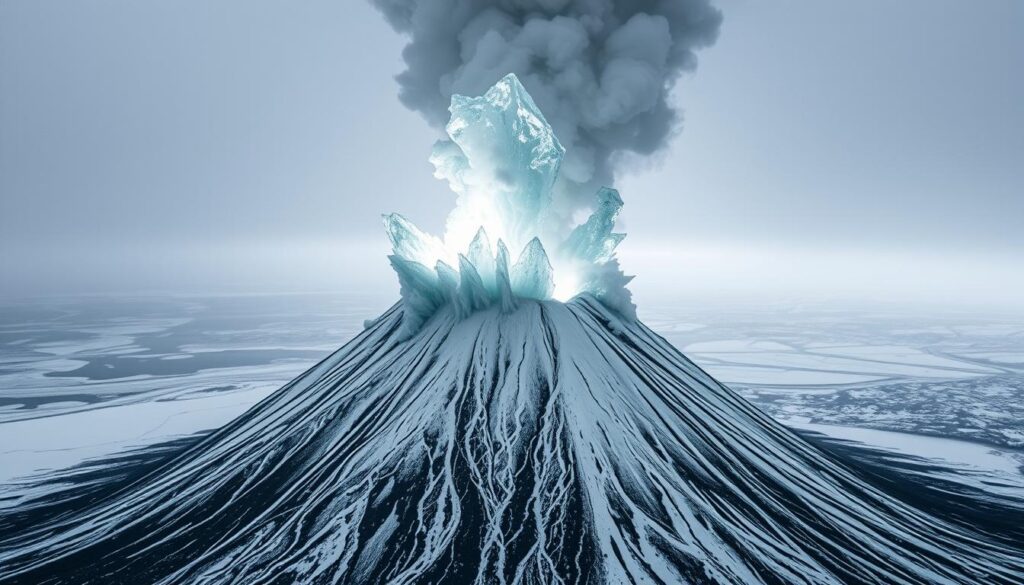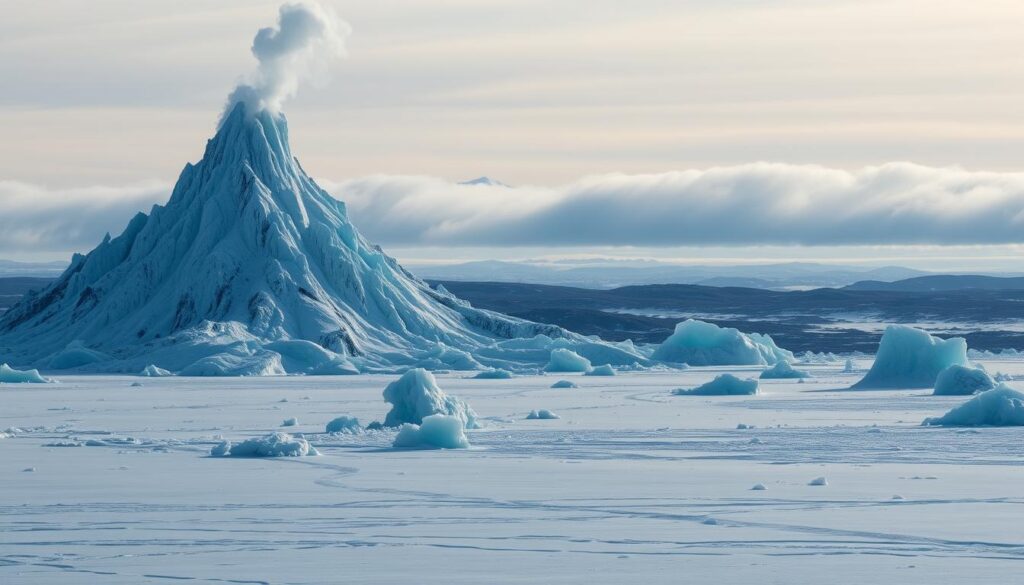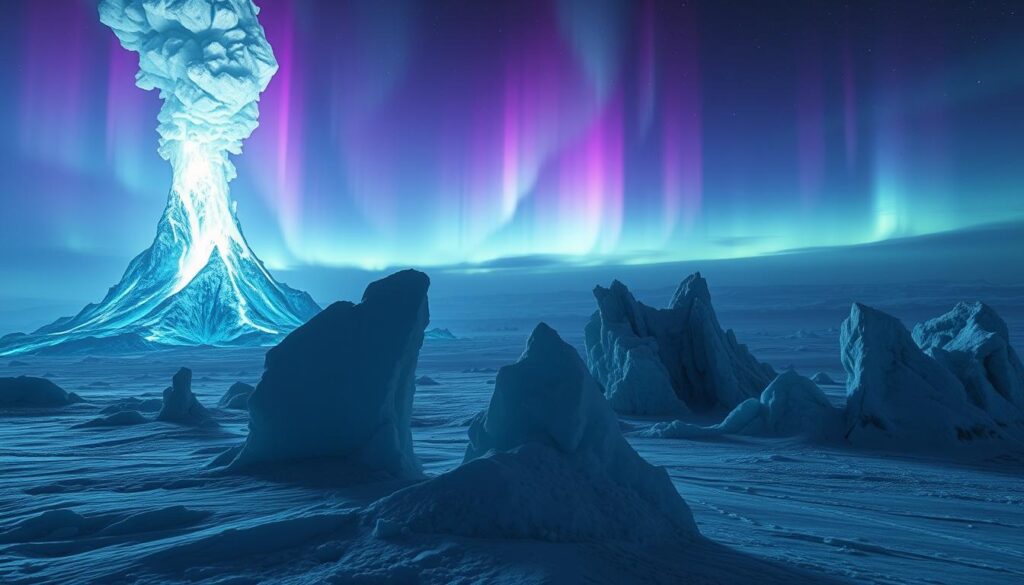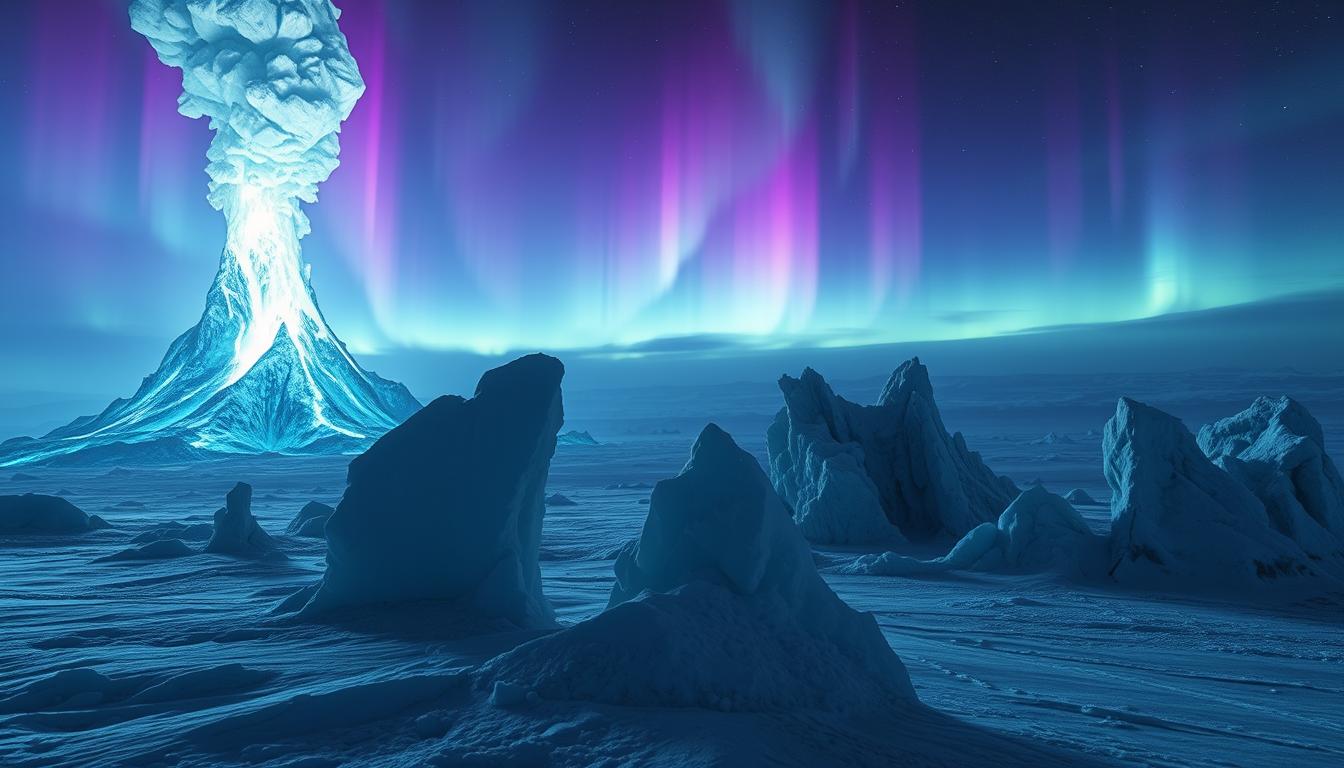A unique natural phenomenon has been discovered, where a volcano erupts ice instead of lava. This rare occurrence is a fascinating display of the complexity and diversity of geological processes on our planet. The study of this phenomenon can provide valuable insights into the Earth’s internal dynamics and the formation of unique landscapes.
The volcano, in this case, is not spewing out hot molten lava. Instead, it is ejecting ice, making it a remarkable sight to behold. This is an important area of research in the field of natural phenomenon.

The discovery of a volcano that erupts ice is significant. It challenges our traditional understanding of volcanic activity and the role of lava in shaping our planet’s surface. This phenomenon is not only interesting from a scientific perspective but also has important implications for our understanding of the Earth’s climate and geological history.
By studying this unique type of volcano, scientists can gain a better understanding of the processes that shape our planet. They can also learn about the potential risks and benefits associated with this type of geological activity. This includes the impact on the environment and the formation of unique ice structures.
Introduction to Ice Volcanoes
Ice volcanoes are a rare and poorly understood phenomenon. They have the potential to reveal important information about the Earth’s internal dynamics and the formation of unique landscapes. The study of ice volcanoes can provide valuable insights into the geological processes that shape our planet.
As researchers continue to explore and study this phenomenon, we can expect to learn more. We will gain a better understanding of the complex interactions between the Earth’s interior and its surface. We will also learn about the role of ice in shaping our planet’s landscape, including the effects of ice volcano eruptions on the environment and the potential for unique geological formations.
Key Takeaways
- Volcanoes can erupt ice instead of lava, creating a unique and fascinating natural phenomenon.
- The study of ice volcanoes can provide valuable insights into the Earth’s internal dynamics and geological history.
- Ice volcanoes are a rare and poorly understood phenomenon, but they have the potential to reveal important information about the Earth’s surface processes.
- The discovery of ice volcanoes challenges our traditional understanding of volcanic activity and the role of lava in shaping our planet’s surface.
- Ice volcanoes can provide important information about the Earth’s climate and geological history, including the potential risks and benefits associated with this type of geological activity.
- Researchers are continuing to explore and study this phenomenon to learn more about the complex interactions between the Earth’s interior and its surface.
The Unusual Discovery of Ice-Erupting Volcanoes
The discovery of ice-erupting volcanoes has changed our view of the universe. It shows us cryovolcanism, where frozen materials like water and ammonia erupt. This has given us new insights into how planets and moons are shaped.
Scientists are excited about ice volcanoes and their role in space. These volcanoes erupt frozen materials, creating unique landscapes. By studying these landscapes, we learn more about the history of planets and moons.
- Unique eruption styles, such as the eruption of frozen particles and gases
- Diverse geological features, including ice shields, cryovolcanic cones, and frozen lava flows
- Association with volcanic activity in various planetary environments, including terrestrial and extraterrestrial settings
Studying ice volcanoes and cryovolcanism is key to understanding our universe. It helps us see how planets and moons are formed. This knowledge is crucial in the search for life beyond Earth.
Understanding How a Volcano Erupts Ice Instead of Lava
Volcanoes are often seen erupting lava, but some erupt ice. This is due to geological phenomena happening during an eruption. The process involves water and other compounds moving beneath the Earth’s surface.
When a volcano erupts, magma from deep inside the Earth comes up. But in ice volcanoes, water and volatile compounds take its place. As pressure drops, these frozen compounds are released, causing ice to erupt.
Studying ice volcanoes helps us understand our planet better. It shows how volcanic activity and water shape the Earth’s surface. This knowledge is key to understanding volcanic eruptions.
Several factors decide if a volcano erupts ice or lava. These include:
- Temperature: The magma and rock temperatures are crucial.
- Pressure: The release pressure affects the eruption type.
- Composition: The magma or water’s chemical makeup matters too.
In summary, ice eruptions are complex and linked to geological phenomena and volcanic eruptions. By studying ice volcanoes, scientists learn more about volcanic activity and the Earth’s surface.
The Science Behind Cryovolcanism
Cryovolcanism is a fascinating phenomenon where frozen materials like water, ammonia, and methane erupt instead of molten rock. This happens due to temperature mechanics and pressure systems found in cryovolcanic environments. To grasp cryovolcanism, we must explore the science behind these eruptions.
Research into cryovolcanism reveals how temperature mechanics, pressure systems, and chemical makeup interact. For example, the freezing and thawing of materials can create pressure. This pressure can lead to a cryovolcanic eruption. The pressure systems in cryovolcanism differ from those in traditional volcanology. They are shaped by the viscosity of frozen materials and the environment.
- Low temperatures, which allow for the existence of frozen materials
- High pressures, which can build up and lead to eruptions
- Unique chemical compositions, which can influence the behavior of the frozen materials
These elements together create an environment perfect for cryovolcanic activity. They also have big implications for our understanding of cryovolcanism and its role in shaping celestial bodies’ surfaces.
Where Ice Volcanoes Are Found in Our Solar System
Ice volcanoes are found in many places in our solar system. They erupt with ice instead of lava. This creates a unique landscape that is both beautiful and intriguing.
These volcanoes are found on several moons around Saturn, like Enceladus and Titan. These moons have the right conditions for ice volcanoes, like very low temperatures and water ice. Studying ice volcanoes helps us understand how other planets and moons are shaped.
Some key places for ice volcanoes in our solar system include:
- Enceladus: This moon of Saturn has geysers of water vapor and organic compounds that erupt from its southern pole, indicating the presence of an ice volcano.
- Titan: Saturn’s largest moon has lakes of liquid methane and seas of frozen methane, which are thought to be fed by ice volcanoes.
- Pluto: This dwarf planet has evidence of recent ice volcanic activity, with features such as ice flows and volcanic-like landforms.
Scientists are very interested in studying ice volcanoes. They use many methods to learn about these unique features. By exploring ice volcanoes, we can understand more about the geological processes on other planets and moons.
Famous Examples of Cryovolcanic Activity
Cryovolcanic activity is a fascinating phenomenon found in our solar system. On Earth, it involves the eruption of frozen materials like water and ammonia. This is different from the molten rock eruptions we’re used to.
This type of activity is linked to earth-based occurrences. It happens when tectonic plates move or pressure builds up in the Earth’s crust.
One famous example is Pluto’s ice volcanoes. These volcanoes erupt with frozen materials like nitrogen and methane. Studying them helps us understand cryovolcanic activity on other celestial bodies.
Recent Discoveries
Recent findings have revealed more about cryovolcanic activity. For instance, ice volcanoes on Titan, Saturn’s largest moon, have been discovered. These volcanoes erupt with frozen materials like water and ammonia.
Studying cryovolcanic activity is key to understanding our solar system. It helps scientists learn about the formation and evolution of planets and moons.
The Role of Water in Ice Volcano Formation
Water is key in making ice volcanoes. It starts with water freezing into ice. Then, this ice gets compressed and heated, turning it into liquid water.
This liquid water is vital for ice volcanoes. It gives the heat and pressure needed for eruptions. It also makes the ice flow easily, creating the volcano’s shape. Plus, it can mix with other substances like ammonia or methane, creating a cryogenic mixture that erupts.

The water in ice volcanoes changes how they erupt. If there’s a lot of water, eruptions can be bigger and more explosive. But if there’s less water, eruptions are smaller and less intense. Knowing how water affects ice volcanoes helps us predict and prepare for eruptions.
Several things affect water’s role in ice volcano formation:
- Temperature: The environment’s temperature influences how fast ice forms and melts.
- Pressure: The pressure on the ice and water mixture determines eruption speed and style.
- Chemical composition: Substances like ammonia or methane can change the ice and water mixture’s properties.
Environmental Impact of Ice-Erupting Volcanoes
The eruption of ice volcanoes has a big environmental impact on the area around them. The local ecosystem effects can be huge, changing the environment’s balance. The release of frozen materials like water and gases can change the soil and water chemistry. This can affect the plants and animals living there.
Some of the main effects of ice volcano eruptions on the environment include:
- Changes in soil chemistry and composition
- Alterations to local water sources and quality
- Impacts on the diversity and distribution of local plant and animal species
Ice volcano eruptions also have wider climate implications. The release of gases like methane and carbon dioxide can lead to climate change. The formation of new ice can change sea levels and ocean currents. It’s important to understand the environmental impact of ice volcanoes to predict and lessen their effects on our planet.
Studying Ice Volcanoes: Research Methods and Tools
Scientists use many ways to study ice volcanoes. They collect data on how these volcanoes form, erupt, and behave. This helps us learn more about them. Common methods include remote sensing, field observations, and lab experiments.
Remote sensing uses satellites or planes to study ice volcanoes from afar. It shows the volcano’s shape, size, and eruption patterns. Field observations involve going to the volcano site. Researchers use seismometers to measure earthquakes and thermocouples to track temperature changes.
Important tools for studying ice volcanoes include:
- Ground-penetrating radar to see inside the volcano
- Ice cores to study the ice’s chemical makeup
- Drone technology for detailed volcano images
By using these methods and tools, scientists can understand ice volcanoes better. This knowledge helps us know more about our planet’s geology and climate.
Future Predictions for Ice Volcanic Activity
Scientists are studying ice volcanoes to predict their future impact. They focus on how climate change might change ice volcano activity. They aim to understand how rising temperatures and environmental shifts will affect these volcanoes.
Some key areas they’re looking into include:
- Monitoring ice volcano activity to better understand patterns and trends
- Studying the impact of climate change on ice volcano formation and eruption
- Developing new technologies to track and predict ice volcano activity
By studying these factors and using new technologies, scientists can make better future predictions. This knowledge helps us prepare for the effects of climate change effects on our planet.

| Prediction | Climate Change Effect | Monitoring Technology |
|---|---|---|
| Increased ice volcano activity | Rising temperatures | Advanced satellite imaging |
| Changes in eruption patterns | Shifts in global weather patterns | Seismic monitoring systems |
| More frequent ice volcano eruptions | Melting of polar ice caps | Ground-penetrating radar |
Comparing Traditional and Ice Volcanoes
Most people think of volcanoes as places where molten lava erupts. But ice volcanoes, or cryovolcanoes, are different. They erupt with frozen materials like water, ammonia, or methane. Let’s look at how traditional volcanoes and ice volcanoes differ, focusing on their structure and eruption patterns.
Traditional volcanoes are steep and found where tectonic plates meet. Ice volcanoes, on the other hand, are gentler and found on other planets and moons. The structural differences are clear. Traditional volcanoes are solid, while ice volcanoes are made of frozen materials that can flow.
Unique Characteristics of Ice Volcanoes
- Composition: Ice volcanoes are made of frozen materials like water, ammonia, or methane.
- Structure: Ice volcanoes have a gentler slope and are found on other planets and moons.
- Eruption patterns: They erupt with frozen materials, creating unique geological features.
Understanding the differences between traditional and ice volcanoes helps us learn about our planet and others. By studying these volcanoes, scientists can uncover more about their structural differences and eruption patterns. This knowledge helps us understand the universe better.
The Importance of Ice Volcanoes in Planetary Science
Ice volcanoes are key in planetary science. They help us understand how planets form and change. By studying these volcanoes, scientists learn more about our solar system and the universe. This shows how important these unique features are.
Looking into ice volcanoes is vital in planetary science. It helps researchers find out if life exists elsewhere. Since ice volcanoes have water and organic compounds, they might support life. This makes them very interesting to study.
- Formation and evolution of planets
- Composition and behavior of ice volcanoes
- Potential for life beyond Earth
In summary, ice volcanoes are crucial in planetary science. They give us a special look into how our planet and others came to be. Their importance is huge, as they help us understand life beyond Earth and the solar system’s processes.
Conclusion: The Revolutionary Impact of Ice Volcano Discovery
The discovery of ice volcanoes has changed how we see the Earth and other planets. These amazing sights were once thought to be only in science fiction. But now, we know they are real and show us how planets change over time.
Ice volcanoes are found on the moons of Jupiter and Saturn, and even on Earth. They mix cold science with hot volcanic activity. This mix challenges our old ideas about how planets and moons grow and change.
As we learn more about ice volcanoes, their importance in space science grows. They help us understand how water and other volatile compounds shape planets. This knowledge also gives us hints about life beyond Earth and how our planet evolved.
The study of ice volcanoes is still uncovering new secrets. It promises to bring even more groundbreaking discoveries. These findings will help us understand the universe even better in the future.
FAQ
What are ice-erupting volcanoes?
Ice-erupting volcanoes, also known as cryovolcanoes, are volcanoes that erupt ice instead of lava. They are found on Earth and other planets. Scientists find them very interesting.
How do ice volcanoes form?
Ice volcanoes form when certain conditions are met. This includes the right temperature, pressure, and chemical makeup. Volatiles like water and methane build up and then erupt as ice.
Where can ice volcanoes be found?
Ice volcanoes are found on Earth and other planets. For example, Saturn’s moon Enceladus and the dwarf planet Ceres have them. They are quite common in our solar system.
What are the environmental impacts of ice-erupting volcanoes?
Ice volcanoes can change the environment around them. They can alter landscapes and affect local ecosystems. They also play a role in climate change by changing the atmosphere.
How do scientists study ice volcanoes?
Scientists use many methods to study ice volcanoes. They use satellites, ground surveys, and lab tests. These tools help them understand how ice volcanoes work.
What are the future predictions for ice volcanic activity?
Scientists are trying to predict when ice volcanoes will erupt next. They look at climate change and new technology. This helps them prepare for future eruptions.
How do ice volcanoes differ from traditional volcanoes?
Ice volcanoes are different from lava volcanoes in many ways. They erupt ice, not lava. They also have different shapes and erupt under different conditions.
Why are ice volcanoes important in planetary science?
Ice volcanoes are key to understanding planets and moons. They help scientists learn about water and life on other worlds. This knowledge is crucial for studying habitability and life beyond Earth.
